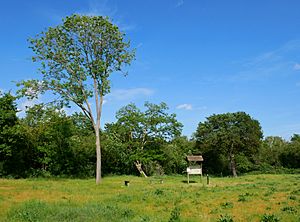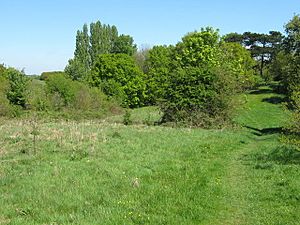Dartford Heath facts for kids
Dartford Heath Common is a large open space in Kent, England. It's located southwest of Dartford. This special area covers about 314 acres.
Dartford Heath is a type of land called "lowland heath." It's one of only two big heathland areas left in Kent. Many rare plants and small creatures live here. You can also spot reptiles like common lizards and slow-worms, plus rabbits.
History of Dartford Heath
People have lived on Dartford Heath for a very long time. Archeologists have found many ancient items here. These include tools from the Stone Age and Bronze Age. There are also old burial mounds, called barrows, on the heath.
Since the Middle Ages, Dartford Heath has been important to local people. It was known as "common land." This meant people could use it for things like grazing animals. Because of this, the land was not fenced off like other areas in the 1700s and 1800s.
During that time, the Tredegar family owned the heath. They dug up a lot of natural resources. They removed granite, chalk, and other materials. In the 1830s, many deep holes and pits were seen. Some were like narrow tunnels that opened into larger rooms underground. These were likely dug to get chalk, which was used for building and helping farm soil.
An old historian, Edward Hasted, thought some of these holes might have been secret hiding places. He believed ancient Saxons used them to hide their families and belongings during wars. By 1844, most of these dangerous holes were filled in. This helped prevent accidents for people and animals.
The first Baron Tredegar owned the heath. He tried to limit public access. But his tenants were still allowed to graze their cattle there. In 1832, a special meeting was held. It confirmed that the public should have the right to use most of the heath.
However, a lot of granite, chalk, and turf were still dug up. This continued until 1925. That year, a new law made it harder for landowners to damage common lands. The owner, Courtenay Morgan, then sold the heath to Dartford Urban District Council. After that, most of the digging stopped.
You can still see large dips and mounds on the heath today. These are left over from the old mining work. In the 1800s, clay was dug from the north side of the heath. This clay was used to make bricks. The parallel mounds left behind are known as the Glory Bumps.
Dartford Heath has also been a place for sports and military training. The first local cricket game was played here in 1723. A group called the Royal Kentish Bowman met here between 1785 and 1802. Even King George IV was a member! The area nearby is still called Bowmans.
Soldiers were stationed on Dartford Heath in 1779-80. They returned during World War II. A Royal Artillery anti-aircraft unit was based there. You can still see the old tarmac roads from their camp.
Dartford Heath Today
Since 1925, Dartford Heath has mostly kept its natural look. However, some parts were changed by road building. The first Dartford bypass was built around 1930. Then, the A2 dual carriageway was built in 1973. This road cut off some southern parts of the heath.
The heath has three ponds: Donkey Pond, Woodland Pond, and North Pond. Sometimes, these ponds dry up in hot weather. The heath has different types of natural areas. These include grassy areas, woodlands with oak and birch trees, and areas with heather and gorse bushes.
Dartford Heath is a popular place for people to relax and exercise. Many cyclists and dog walkers enjoy the open space. Sometimes, rubbish from a nearby recycling center can blow onto the roads near the heath.
People work to keep the heath healthy. They try to stop bushes from growing too much. They also work to prevent fires and help the heath plants grow well.
For many years, Dartford Heath was a place where people could fly model aircraft. But this was stopped in 2003 for safety reasons. Skateboarding and other similar activities have also been banned for a long time.
There is a small car park for visitors on Heath Lane (Upper).
The Dartford Warbler
Many people think the bird called the Dartford warbler was first seen on Dartford Heath. But this is not quite right! The bird was first described in 1776. It was seen on Bexley Heath, which is near Dartford. Parts of Bexley Heath were once in the Dartford area. That's why the bird got its name.






